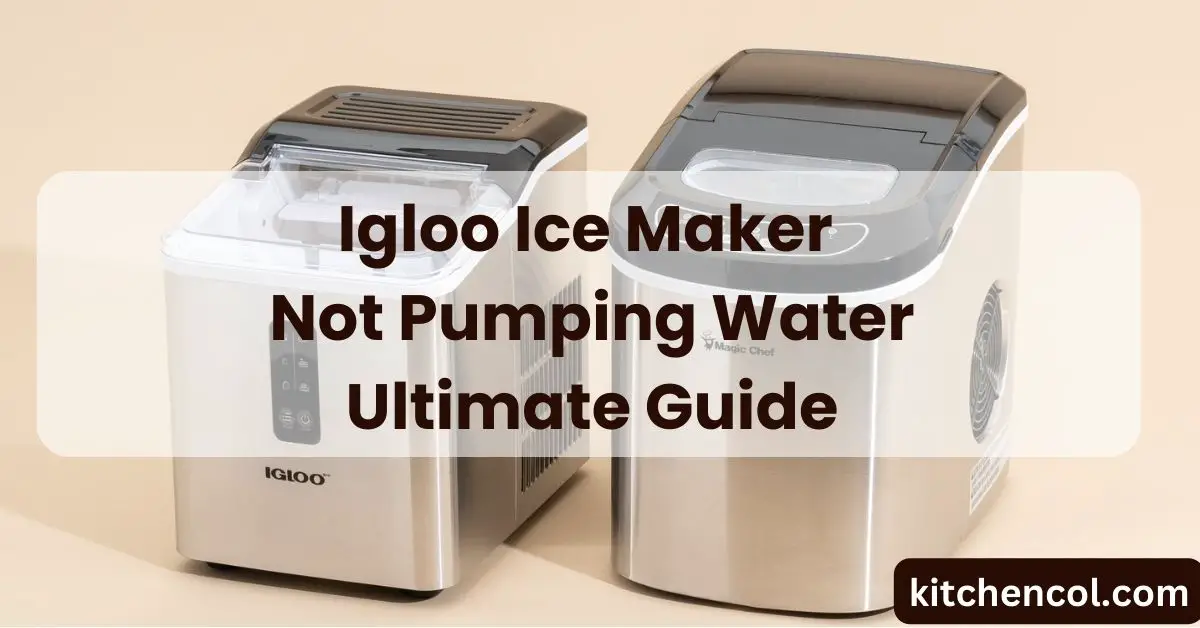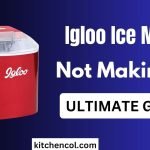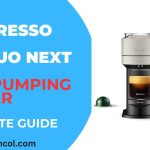Ice makers have become a staple appliance in many homes and businesses, providing a convenient supply of ice for various needs. However, encountering an issue where your Igloo ice maker isn’t pumping water can disrupt its functionality, resulting in a lack of ice production.
Understanding the root causes behind this problem and knowing how to troubleshoot it can save time and potentially avoid costly repairs. In this guide, we’ll delve into the common reasons why an Igloo ice maker may stop pumping water and provide step-by-step troubleshooting tips to help you get your ice maker back up and running efficiently.
Understanding the Igloo Ice Maker and Its Components
Ice makers, including those manufactured by Igloo, are intricate appliances designed to produce ice cubes efficiently. To comprehend why an Igloo ice maker might stop pumping water, it’s crucial to grasp the key components integral to its functioning.
A. Components Overview:
- Water Reservoir: This reservoir stores the water that the ice maker uses to create ice cubes.
- Water Pump: The water pump is responsible for circulating water from the reservoir to the ice-making mechanism.
- Water Filter: Often included in ice makers, the filter ensures the quality of the water used in ice production by removing impurities.
- Valves and Tubing: These components facilitate the flow of water within the ice maker, controlling its distribution to the freezing chamber.

B. Water Pumping System:
- The water pump serves as the heart of the ice maker, ensuring a continuous flow of water to create ice cubes.
- When activated, the pump propels water through the tubing and valves, directing it to the freezing tray where the ice forms.
C. Role of Water Pump in Ice Production:
- The proper functioning of the water pump is critical for consistent ice production. Any interruption in its operation can lead to a halt in the ice-making process.
- The pump’s failure to circulate water results in a lack of water supply to the freezing tray, ultimately preventing ice cube formation.
D. Diagram/Visual Aid (Optional):
- An illustrative diagram or visual representation may aid in understanding the interplay between components and the water pumping system within an Igloo ice maker.
Understanding these components lays the groundwork for identifying potential issues and troubleshooting why an Igloo ice maker may cease to pump water effectively.
Common Reasons Why an Igloo Ice Maker Might Stop Pumping Water
An Igloo ice maker’s inability to pump water can stem from various underlying issues, hindering its functionality. Understanding these common reasons can significantly aid in troubleshooting the problem effectively.
A. Lack of Water Supply:
- Water Line Issues: Check for kinks, bends, or blockages in the water supply line connected to the ice maker. Any obstruction can impede the flow of water to the ice maker.
- Water Source Problems: Ensure the water source supplying the ice maker has adequate pressure and is turned on. Low water pressure or a disconnected supply can cause a lack of water flow.
B. Clogged Water Filter:
- A clogged or dirty water filter can restrict water flow to the ice maker, affecting its ability to pump water effectively.
- Regular cleaning or replacement of the filter, as recommended by the manufacturer, is crucial to maintain optimal water quality and flow.
C. Malfunctioning Water Pump:
- Over time, the water pump might experience wear and tear, resulting in decreased efficiency or complete failure.
- Signs of a faulty pump include unusual noises, reduced water flow, or complete cessation of water circulation.
D. Electrical Issues:
- Faulty electrical connections, damaged wiring, or issues with the ice maker’s electrical components can disrupt the pump’s operation.
- Conduct a thorough inspection of electrical connections to identify and rectify any potential problems.
E. Other Potential Causes:
- Sensor Malfunctions: Issues with sensors detecting water levels or pump activation can affect the water-pumping mechanism.
- Blockages or Internal Damage: Internal blockages or damage within the ice maker’s components might hinder water flow and pump operation.
Understanding these common issues helps pinpoint potential problems when an Igloo ice maker stops pumping water, enabling users to proceed with targeted troubleshooting steps.
Troubleshooting Steps for an Igloo Ice Maker Not Pumping Water
When faced with an Igloo ice maker that isn’t pumping water, a systematic approach to troubleshooting can help isolate and resolve the issue effectively.
A. Step 1: Checking the Water Supply
- Inspect Water Line: Examine the water supply line for kinks, twists, or blockages. Straighten any bends and ensure a clear, unobstructed path for water flow.
- Verify Water Source: Ensure the water supply connected to the ice maker is turned on and provides adequate water pressure.
B. Step 2: Inspecting and Cleaning the Water Filter
- Locate the water filter in the ice maker and follow the manufacturer’s instructions to remove, clean, or replace it as necessary.
- Cleaning the filter eliminates potential blockages that might impede water flow.
C. Step 3: Testing the Water Pump
- Observation for Signs of Malfunction: Listen for unusual noises emanating from the ice maker, which might indicate a malfunctioning water pump.
- Manual Testing: Activate the ice maker and observe if the water pump is operational. Lack of water movement or pumping indicates a potential issue with the pump.
D. Step 4: Verifying Electrical Connections
- Inspect all electrical connections, including power outlets, wiring, and connections within the ice maker, for any signs of damage or loose connections.
- Ensure the ice maker is receiving an adequate power supply and that all connections are secure.
E. Step 5: Additional Checks and Considerations
- Sensor Verification: Check sensors responsible for detecting water levels or activating the pump. Reset or replace sensors if they’re malfunctioning.
- Internal Blockages/Damage: If other troubleshooting steps don’t resolve the issue, consider seeking professional assistance to investigate potential internal blockages or component damage.
By following these systematic steps, users can identify and potentially resolve the problem of an Igloo ice maker not pumping water. If the issue persists despite these efforts, seeking professional help might be necessary.
Maintenance Tips to Prevent Future Issues
Regular maintenance is key to ensuring the optimal performance and longevity of an Igloo ice maker. Implementing preventive measures can significantly reduce the likelihood of encountering problems, including issues with water pumping.
A. Regular Cleaning:
- Clean the Water Reservoir: Periodically clean the water reservoir to prevent the buildup of impurities or residues that could affect water quality and pump functionality.
- Maintain the Water Filter: Follow manufacturer recommendations to clean or replace the water filter at specified intervals, ensuring unobstructed water flow.
B. Check Water Supply and Connections:
- Inspect Water Supply Line: Routinely examine the water supply line for any potential kinks, bends, or blockages that might hinder water flow.
- Tighten Connections: Periodically check and tighten any loose connections to ensure a secure and uninterrupted water supply to the ice maker.
C. Professional Servicing:
- Scheduled Inspections: Consider scheduling regular professional servicing or inspections, especially if the ice maker is used frequently or in a commercial setting.
- Addressing Early Signs of Issues: Act promptly upon noticing any irregularities or early signs of problems, such as unusual noises or reduced ice production.
D. Power and Electrical Considerations:
- Stable Power Supply: Ensure the ice maker is connected to a stable power source to prevent electrical issues that could affect its pumping mechanism.
- Follow Manufacturer’s Instructions: Adhere to the manufacturer’s guidelines for power usage and electrical maintenance.
E. Environmental Factors:
- Temperature Regulation: Maintain a suitable operating environment for the ice maker, avoiding extreme temperatures that could affect its components.
- Ventilation: Ensure proper ventilation around the ice maker to prevent overheating or condensation-related issues.
Implementing these maintenance practices can significantly contribute to the efficient functioning of an Igloo ice maker, reducing the likelihood of water pumping issues and extending its lifespan.
Conclusion
An Igloo ice maker not pumping water can disrupt ice production, causing inconvenience. Understanding common causes such as water supply issues, pump malfunctions, or electrical faults is crucial.
By following systematic troubleshooting steps and embracing regular maintenance practices like cleaning, checking connections, and scheduling professional inspections, users can prevent and address these issues effectively.
Maintaining optimal conditions for the ice maker ensures uninterrupted water flow, prolongs its lifespan, and guarantees a consistent supply of ice for various needs, thereby maximizing its efficiency and functionality in both residential and commercial settings.

My name is Manan Bukhari and I am an expert in reviewing kitchen products for years. I have a passion for testing multiple gadgets especially related to home & kitchen. I love to spend my free time in resolving issues if I face some in any of my daily use things. I have fixed multiple gadgets of my home on my own without any assistance and that thing gave me confidence to make a blog on troubleshooting of items that are for daily use to assist you folks. Even my wife praises me for having such talent. I always explore new machines on my own because this thing fascinates me.



